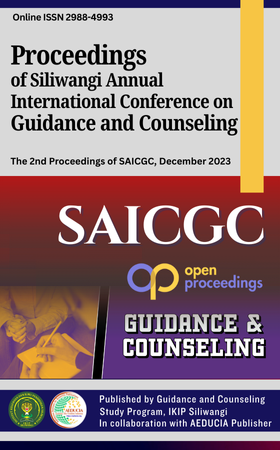YouTube triggers Phubbing and FoMO behavior in generation Z
DOI:
https://doi.org/10.64420/saicgc.v2i1.50Keywords:
generation Z, YouTube, Phubbing, FoMoAbstract
Youtube, as a giant video platform, has had a huge impact on the behavior and habits of generation Z. Phubbing (Phone Snubbing) and FoMO (Fear of Missing Out) are two psychological phenomena that can be related to the use of Youtube and social media in general. It is always important to understand and manage digital behavior patterns wisely to create a healthy balance between the virtual world and the real world. This research uses a quantitative approach with descriptive methods. Sampling used random sampling techniques, the sample in this study was 151 high school students in Padang City. The scales used in this research are the FoMO and Phubbing scales. This research uses three analyses, including: 1) descriptive test of FoMO and Phubbing in Padang City; 2) descriptive test of students' FoMO and Phubbing based on gender; 3) descriptive test of students' FoMO and Phubbing based on 1 month quota usage; 4) descriptive test of students' FoMO and Phubbing based on internet access; and 5) The connection between social media and internet access. Data were analyzed using descriptive analysis with the help of JASP software. The results of the research are: 1) Testing FoMO-Phubbing Conditions Based on Gender shows that there is no significant difference between the levels of FoMO and phubbing between male and female students, 2) Testing FoMO-Phubbing Conditions Based on 1 Month Quota, shows that the sample group that uses quota of more than 4 Gb has the highest phubbing score, then in the FoMO score, the sample group that uses cellular data quota in the 1 Gb to 4 Gb category with tethering has the highest FoMO score, 3) Testing FoMO-Phubbing Conditions Based on Internet Access shows that the score is good FoMO and phubbing students use their own internet quota access. This shows that, without dependence on a particular type of internet access, both FoMO and phubbing remain related to the use of mobile data quota. 5) The association between internet access and social media tendencies suggests that students who use tethering access to watch YouTube may have different experiences or behaviors. different in terms of FoMO (Fear of Missing Out; figure 5) and phubbing compared to those who use personal quotas to access other social media such as Instagram, Facebook, and Twitter. the results of this study remind us of the importance of considering differences in the use of internet access and social media platforms when designing educational interventions or programs aimed at reducing the negative impact of FoMO and phubbing on students.
References
Afdal, A., Alizamar, A., Ifdil, I., Ardi, Z., Sukmawati, I., Zikra, Z., Ilyas, A., Fikri, M., Syahputra, Y., & Hariyani, H. (2019). An Analysis of Phubbing Behaviour: Preliminary research from counseling perspective. 1st International Conference on Educational Sciences and Teacher Profession (ICETeP 2018). Atlantis Press, 295, 270–273. http://creativecommons.org/licenses/by-nc/4.0/
Berkup, S. B. (2014). Working with generations X and Y in generation Z period: Management of different generations in business life. Mediterranean journal of social Sciences, 5(19), 218.
Chandra, E. (2017). Youtube, citra media informasi interaktif atau media penyampaian aspirasi pribadi. Jurnal Muara Ilmu Sosial, Humaniora, dan Seni, 1(2), 406-417.
Chaudry, L. A. (2015). Can you please put your phone away? Examining How the FOMO phenomenon and mobile phone addiction affect human relationships. VCU Scholars Compass.
Chen, G.M., & Strarosta, W.J. (2005). Foundations of Intercultural Communication. Lanham, MD: University Press of Amerika.
Cohen, L., Manion, L., & Morrison, K. (2002). Research methods in education. routledge.
DeVito, J. A. (2015). Human Communication. The Basic Course. Thirteenth Edition. USA: Pearson Education.
Dill, K. (2015). 7 Things Employer should know about the gen Z workforce. Forbes Magazine, 11(6),https://www.forbes.com/forbes/www.forbes.co m/sites/kathryndill/2015/11/06/7-things-employersshould-know-about-the-gen-z-workforce/
Fitriyani, P. (2018). Pendidikan karakter bagi generasi Z. Prosiding Konferensi Nasional Ke-7 Asosiasi Program Pascasarjana Perguruan Tinggi Muhammadiyah Aisyiyah (APPPTMA). Jakarta, 23-25.
Fuster, H., Carbonell, X., Pontes, H. M., & Griffiths, M. D. (2016). Spanish Validation of the Internet Gaming Disorder-20 (IGD-20) Test. Computers in Human Behavior, 56, 215-224. doi: 10.1016/j.chb.2015.11.050.
Gazali, H. (2019). Islam Untuk Gen Z: Mengajarkan Islam, Mendidik Muslim Generasi Z: Panduan Bagi Guru PAI. Jakarta: Wahid Foundation.
Goss Sampson, M. (2019). Statistical analysis in JASP: A guide for students. University of Greenwich.
Hanika, I. M. (2015). Fenomena phubbing di era milenia (ketergantungan seseorang pada smartphone terhadap lingkungannya). Interaksi: Jurnal Ilmu Komunikasi, 4(1), 42-51.
Hastini, L. Y., Fahmi, R., & Lukito, H. (2020). Apakah Pembelajaran Menggunakan Teknologi dapat Meningkatkan Literasi Manusia pada Generasi Z di Indonesia?. Jurnal Manajemen Informatika (JAMIKA), 10(1), 12-28.
Herlyana, F., & Utami, L. S. S. (2020). Pengaruh daya tarik iklan di konvergensi media terhadap brand awareness (Studi iklan Tiket. com di YouTube pada kalangan generasi Z di Jakarta). Prologia, 4(1), 160-166.
Karadag, E., Tosuntas, S. B., Erzen, E., Duru, P., Bostan, N., Mızrak Sahin, B., Culha, İ., & Babadag, B. (2016). The Virtual World’s Current Addiction: Phubbing. Addicta: The Turkish Journal on Addictions, 3(2). https://doi.org/10.15805/addicta.2016.3.0013
Kristyowati, Y. (2021). Generasi “Z” Dan Strategi Melayaninya. Ambassadors: Journal of Theology and Christian Education, 2(1), 23-34.
Lee, W. J. (2013, July). An exploratory study on addictive use of smartphone: Developing SAUS (Smartphone Addictive Use Scale). In International Conference on Convergence Technology (Vol. 2, No. 1, pp. 2027-2028). 한국융합학회.
Lestari, R. (2017). Pengunaan Youtube Sebagai Media Pembelajaran Bahasa Inggris. Prosiding Seminar Nasional Pendidikan Berkemajuan dan Menggembirakan (The Progressive & Fun Education Seminar) ke-2.
Linacre, J. M. (2016). Winsteps® Rasch measurement computer program.
Prabayanti, H. R., Sari, Y. K. P., & Emmanuel, P. (2020). Perspektif Komunikasi Generasi Z Terhadap Pengobatan Alternatif Ningsih Tinampi yang Viral di Youtube. Jurnal Representamen Vol, 6(01).
Przybylski, A. K., Murayama, K., Dehaan, C. R., & Gladwell, V. (2013). Motivational, emotional, and behavioral correlates of fear of missing out. Computers in Human Behavior, 29(4), 1841–1848. https://doi.org/10.1016/j.chb.2013.02.014
Przybylski, A. K., Murayama, K., DeHaan, C. R., & Gladwell, V. (2013). Motivational, emotional, and behavioral correlates of fear of missing out. Computers in human behavior, 29(4), 1841-1848.
Putra, Y. S. (2016). TheoriticalReview: Teori Perbedaan Generasi. AmongMakarti, 9(18), 123-134.
Romli, Khomsah Rail. (2016). Komunikasi Massa. Jakarta: PT Grasindo.
Rosdiana, Y. (2023). Sosialisasi Pencegahan Perilaku Pbubbing Pada Generasi Z Di Era Society 5.0: Socialization Of Phubbing Behavior Prevebtion In Generation Z In The Society. JAMAS: Jurnal Abdi Masyarakat, 1(2), 103-107.
Sayrs, E. (2013). The effects of smartphone use on cognitive and social functions. TAM Capstone Thesis Paper. University of Colorado.
Sesva, M., Syahputra, Y., & Erwinda, L. (2022). Predicting Social Media Addiction in Adolescent with Narcistic Variables: Predicting Social Media Addiction in Adolescent with Narcistic Variables. Journal of Learning and Instructional Studies, 2(2), 13–20.
Shatto, B., & Erwin, K. (2016). Moving on from millennials: Preparing for generation Z. The Journal of Continuing Education in Nursing, 47(6), 253-254.
Syahputra, Y., & Afdal, A. (2022). Pengujian Sifat Psikometri Skala Relational Aggression (RA) Versi Indonesia: Rasch Measurement Tool. Cenderawasih Journal of Counseling and Education, 1(1), 1–9. https://doi.org/10.31957/cjgce.v1i1.2342
Syahputra, Y., & Erwinda, L. (2020). Perbedaan Nomophobia mahasiswa; analisis Rasch. JPPI (Jurnal Penelitian Pendidikan Indonesia), 6(2), 69–76.
Syahputra, Y., Ifdil, I., Hafni, M., Solihatun, S., Oktara, T. W., & Erwinda, L. (2022). Narcissism and Social Media Addiction: Gender, Social Demographics, and Social Media Use. COUNS-EDU: The International Journal of Counseling and Education, 7(2).
Syahputra, Y., Rangka, I. B., Solihatun, S., Folastri, S., & Oktasari, M. (2020). Mengukur Sifat Psikometri Phubbing Scale (PS): Rasch Measurement Tool (RMS). In Seminar Nasional Daring IIBKIN 2020, 120–128.
Syahputra, Y., Sandjaja, S. S., Alizamar, A., Afdal, A., & Erwinda, L. (2022). Using Rasch Model to Understand Psychometric Properties of Junior Students Aggressive Behavior Inventory (J-SABI). Jurnal Psikologi, 15(2), 253–268.
Turner, A. (2015). Generation Z: Technology and social interest. The journal of individual Psychology, 71(2), 103-113.
Downloads
Published
How to Cite
Issue
Section
License
Copyright (c) 2025 Dona Fitri

This work is licensed under a Creative Commons Attribution-ShareAlike 4.0 International License.
Authors who publish with this journal agree to the following terms: (1) Authors retain copyright and grant the journal right of first publication with the work simultaneously licensed under a Creative Commons Attribution-ShareAlike 4.0 International. that allows others to share the work with an acknowledgement of the work's authorship and initial publication in this journal; (2) Authors are able to enter into separate, additional contractual arrangements for the non-exclusive distribution of the journal's published version of the work (e.g., post it to an institutional repository or publish it in a book), with an acknowledgement of its initial publication in this journal; (3) Authors are permitted and encouraged to post their work online (e.g., in institutional repositories or on their website) prior to and during the submission process, as it can lead to productive exchanges, as well as earlier and greater citation of published work.




















